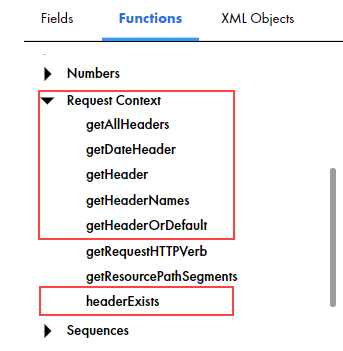Application Integration
- Application Integration
- All Products


Header
| Value
|
|---|---|
accept-language
| en-US;q=0.9
|
client-ip
| 192.0.2.1
|
accept
| text/xml
|
postman-token
| 0023-a5dfd-8vdg3-n2b3
|
CustomHeader
| This is a custom header
|
ExecutionDate
| Wed, July 25 2018 06:25:24 GMT
|
fn:getAllHeaders()
<headers> <header name="accept-language">en-US;q=0.9</header> <header name="client-ip">192.0.2.1</header> <header name="accept">text/xml</header> <header name="postman-token">0023-a5dfd-8vdg3-n2b3</header> <header name="CustomHeader">This is a custom header</header> <header name="ExecutionDate">Wed, July 25 2018 06:25:24 GMT</header> </headers>
fn:year-from-dateTime(request:getDateHeader("ExecutionDate")
request:getHeader("accept")
request:getHeaderNames()
accept-language,client-ip,accept,postman-token,CustomHeader,ExecutionDate
concat ("The header I want is", request:getHeaderOrDefault("postman-token","Not Avaialble" )
The header I want is 0023-a5dfd-8vdg3-n2b3
concat ("The header I want is", request:getHeaderOrDefault("special-token","Not Avaialble" )
The header I want is Not Available
request:headerExists("CustomHeader")
True
request:getHeader("CustomHeader","ME1")